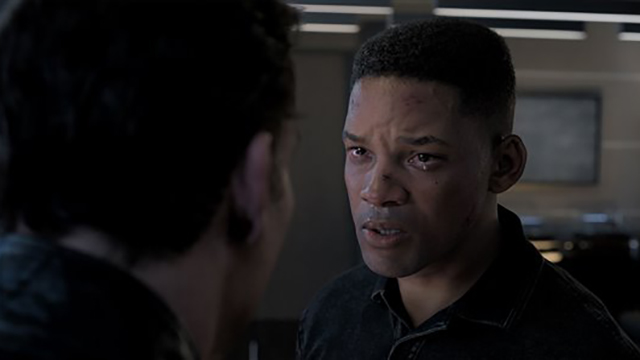Gemini Man is an exciting film, at least in theory. It’s a high-concept, globetrotting sci-fi adventure that stars Will Smith, directed by Ang Lee and produced by Jerry Bruckheimer. Both literally and figuratively, this film is a callback to another era. At the same time, it uses advanced Hollywood technology to achieve its goals in a way that puts the movie in a weird grey space. In other words, Gemini Man should be the ultimate ’90s throwback.
For those who are unaware, the plot of Gemini Man follows an aging hitman who is hunted down by a younger version of himself. With several notable directors attached to the project at various points, Lee seems like an unlikely choice. But that’s what makes the film fascinating. Right from the first images, it becomes glaringly evident that Lee is interested in creating a classic style-over-substance aesthetic. He is fascinated with the technology used to shoot the film, rather than telling a nuanced story within it. While Lee does a decent job of creating an oddly translucent tone, it’s his casting choices that make the film stand out far more than it probably deserves to.
Supporting Glory

As the “double-billed” leading actor in Gemini Man, Smith turns in a set of hit-and-miss performances. He’s certainly not on autopilot here, but his performance is reserved as the older version of himself. It’s not flashy, and it’s hard to tell if that choice is wholly intentional or not. On the flip side, Smith almost does a rock-solid job of bringing the younger version of himself to life. It might be due to the digital wizardry on display, but we get some of the best eye acting of his entire career. It’s just when he opens his mouth that the whole façade begins to crumble.
Even though the film largely rests on Smith’s talents as an actor, it’s the supporting cast who make the most significant impact in Gemini Man. Benedict Wong is excellent as the third-wheel comedic relief character, while Clive Owen manages to turn in a layered performance as the film’s villain. Mary Elizabeth Winstead, however, is easily the standout among the supporting players. Rather than being a love interest, she’s a partner, which makes her character far more interesting and complex. Not only is she a complete badass in the role, but she also manages to hold her own with Smith on screen. Simply put, Gemini Man offers further proof that Winstead is one of the most underutilized actresses working in Hollywood today.
Relying On Tropes

Just like the revolving door of directors throughout the long development of the film, Gemini Man has seen an even more ungodly number of screenwriters on the project. Since Darren Lemke’s original pitch was sold in 1997, a dozen writers have attempted rewrites on the project. While Lemke’s name still attached to the final film, David Benioff and Billy Ray also share a screenwriting credit, with story credits going to both Lemke and Benioff. As a result of this madness, the script feels muddled, to say the least.
It’s a hodge-podge of a screenplay that leans into generic action tropes, such as the aging hitman. The film features convoluted plot points and on-the-nose dialogue. Iffy at best, but even worse, is the fact that the screenplay frequently tells but doesn’t show. While the twists and turns of Gemini Man are mostly straightforward, the climax is an oddity – at least structurally speaking. Without spoiling anything, it’s safe to say that the film doesn’t necessarily earn its sentimental ending. To quote the movie itself, this script is like “the Hindenberg and Titanic crashing into one another.”
For such a high-concept story, Gemini Man is surprisingly hollow on a thematic level. While the film certainly takes a moral stance in this regard, it also has nothing really to say. There’s undoubtedly some interesting real-life context to the central idea, with Smith literally grappling with his former self in the film. Other than this, however, the thematic resonance of the story is non-existent.
A Relic Of The Past

Gemini Man is an unequivocal technical marvel. Indeed, the de-aging of Smith is impressive. But it’s far less effective in the daylight, which is probably why the story takes place mainly at night. The HFR 3D (High Frame Rate) presentation, however, is far more dazzling than the digital effects themselves could ever hope to be. There are a few uses of this technology in the film that create a surreal viewing experience. There are several points where Lee’s use of the HFR format is an absolute revelation. It may not seem fair to say that it’s game-changing. Yet it’s probably the closest we’ve come to hyper-real filmmaking on a massive level so far.
While the HFR technology in Gemini Man is implemented well, it’s hard to understand how it adds to the story. Sure, it certainly gets us one step closer to the other side of the uncanny valley, but it also feels like a gimmick that doesn’t serve a storytelling purpose. Similarly, the action in the film ranges from acceptable to interesting. The commendable old school approach offers (mostly) practical stunts, effects, and fights. However, it inherently lacks any tension or stakes because of the subject matter. Lorne Balfe’s excellent ’90s throwback score is also appreciated here, but it’s not enough to add real tension to the action.
RELATED: Will Smith Won’t Return For The Suicide Squad
Ultimately, Gemini Man features fairly smart filmmaking that is hampered by a watered-down script. Moreover, Lee is more fixated on the technology than telling a solid story. Unlike in his previous films, Lee doesn’t dig deeper into the moral and philosophical ambiguities of the plot. And other than the film’s technical achievements, we essentially get Will Smith doing a sub-par job of playing the younger version of himself. Twenty years ago, a movie like Gemini Man probably would have played like gangbusters. Now, it feels like a messy relic of the past that grasps at technology and sheer ’90s name-recognition to keep itself relevant.
Rating: 2.5/5









